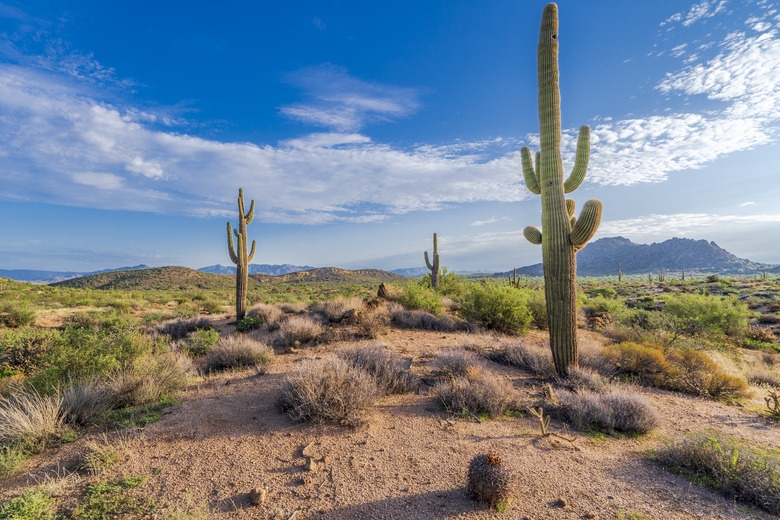What Are The Eight Main Ecosystems?
Merriam-Webster's Online Dictionary defines an ecosystem as "the complex of a community of organisms and its environment functioning as an ecological unit". The Encyclopedia of Global Warming and Climate Change, Volume 1 identifies eight major ecosystems: temperate forest, tropical rain forests, deserts, grasslands, the taiga, the tundra, the chaparral and the ocean.
Temperate Forest
Temperate Forest
Temperate forests exist in the eastern United States and much of Europe. They contain hardwood trees which are deciduous, meaning that they lose their leaves in the autumn. The number of species is limited when compared to a jungle. Inhabitants include raccoons, deer and salamanders.
Tropical Rain Forests
Tropical Rain Forests
Central and South American jungles are prime examples of tropical rain forests. The trees tend to be quite tall, and there are many species. Dense vegetation blocks light from the forest floor. Most plants are evergreen. Tree branches are draped with vines and epiphytes, plants that perch on sturdier plants.
Desert
Desert
Annual rainfall in the desert ranges from zero to 10 inches. Plants consist of cacti, sagebrush and mesquite, plus fast-growing annuals that can quickly start from seed after a rare rain. Desert animals tend to be those that can burrow to escape the desert heat, and they often search for food after dark.
Grasslands
Grasslands
Also called prairie or plains, grasslands receive around 20 inches of rain per year, much of it early in the growing season. Forests are rare, but grasses and herbs thrive. Grass provides food, but animals in the grasslands have little protection from predators. Animals tend to be swift-footed herbivores. Grasslands can easily support grains and other crops.
The Taiga
The Taiga
The taiga land area supports a large population of conifers, particularly spruce and fir. Lakes, bogs and marshes punctuate the landscape. There are fewer types of plants and animals than in the temperate forest. Long, snowy winters set the stage for hibernating mammals and migrating birds.
The Tundra
The Tundra
The tundra lies at extreme latitudes where trees grow little or not at all. Cold winter creates a layer of permafrost under the soil. The growing season is short, producing little except moss, lichens and some grasses and annuals which support Caribou and insects. Birds raise their young in the summer before migrating.
The Chaparral
The Chaparral
The chaparral may receive up to 30 inches of rainfall annually, mostly during the winter. Plants lie dormant during its dry summers. The chaparral is found in California. Trees are mostly oaks. Grapes, olives and figs do well in the chaparral, as do eucalyptus.
The Ocean
The Ocean
The ocean ecosystem has more saltwater than fresh water. The ocean food chain starts with plants and plankton and elevates through smaller fish and crustaceans to whales, seals and dolphins. Tides, currents, sandbars and rock reefs support plant life.
Cite This Article
MLA
Dorsch, Jim. "What Are The Eight Main Ecosystems?" sciencing.com, https://www.sciencing.com/what-are-the-eight-main-ecosystems-12352395/. 22 November 2019.
APA
Dorsch, Jim. (2019, November 22). What Are The Eight Main Ecosystems?. sciencing.com. Retrieved from https://www.sciencing.com/what-are-the-eight-main-ecosystems-12352395/
Chicago
Dorsch, Jim. What Are The Eight Main Ecosystems? last modified March 24, 2022. https://www.sciencing.com/what-are-the-eight-main-ecosystems-12352395/
